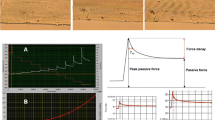Abstract
The myosin heavy chain (MHC) composition of single fibres from m. vastus lateralis of five spinal-cord-injured (SCI) individuals was analysed by Sodium dodecyl sulphate-polyacrylamide gel electrophoresis (SDS-PAGE) before, and after 6 and 12 months of functional electrical stimulation (FES)-training, administrated for 30 min three times per week. Prior to FES training 37.2% of the fibres contained only MHC HB, 21.2% only MHC IIA, and 40.7% co-expressed MHC IIA and MHC IIB. After 6 months of FES-training the number of fibres containing only MHC IIB was reduced to 2.6% (P < 0.05), the number of fibres containing only MHC IIA was increased to 44.3 (P < 0.05), and the number of fibres co-expressing MHC IIA and MHC HB was 50.9% (ns). After 12 months almost all fibres (91.2%,P < 0.05) contained only MHC IIA. The number of fibres containing only MHC IIB was 2.3 % and the fibres co-expressing MHC HA and HB had decreased to 4.6% (P < 0.05). The amount of fibres containing only MHC I never exceeded 0.5%. Likewise, the number of fibres co-expressing MHC I and MHC IIA was below 2% throughout the study period. In total, the MHC composition of 1596 single fibres was determined. This study shows that FES-training of paralysed human skeletal muscle administrated over a prolonged period of time, can lead to a marked switch in MHC expression from about equal amounts of MHC HA and MHC HB to an almost total dominance of MHC HA.
Similar content being viewed by others
References
Adams GR, Hather BM, Baldwin KM, Dudley GA (1993) Skeletal muscle myosin heavy chain composition and resistance training. J Appl Physiol 74:911–915
Andersen JL, Klitgaard H, Bangsbo J, Saltin B (1994) Myosin heavy chain isoforms in single fibres from m. vastus lateralis of soccer players: effects of strength-training. Acta Physiol Scand 150:21–26
Andersen JL, Klitgaard H, Saltin B (1994) Myosin heavy chain isoforms in single fibres from m. vastus lateralis of sprinters: influence of training. Acta Physiol Scand 151:135–142
Ausoni S, Gorza L, Schiaffino S, Gundersen K, Lømo T (1990) Expression of myosin heavy chain isoforms in stimulated fast and slow rat muscles. J Neurosci 10:153–160
Bergström J (1962) Muscle electrolytes in man. Scand J Clin Lab Invest Suppl 68
Ennion S, Sant'Ana Pereira J, Sargeant AJ, Young A, Goldspink G (1995) Characterization of human skeletal muscle fibres according to the myosin heavy chain they express. J Muscle Res Cell Motil 16:35–43
Goldspink G, Scutt A, Martindale J, Jaenicke T, Turay L, Gerlach G-F (1991) Stretch and force generation induce rapid hypertrophy and myosin isoform gene switching in adult skeletal muscle. Biochem Soc Trans 19:368–373
Greve JMD, Muszkat R, Schmidt B, Chiovatto J, Barros TEP, Batistella LR (1993) Functional electrical stimulation (FES): muscle histochemical analysis. Paraplegia 31:764–770
Grimby G, Broberg C, Krotkiewska I, Krotkiewski M (1976) Muscle fiber composition in patients with traumatic cord lesion. Scand J Rehabil Med 8:37–42
Klitgaard H, Mantoni M, Schiaffino S, Ausoni S, Gorza L, Laurent-Winter C, Schnohr P, Saltin B (1990) Function, morphology and protein expression of ageing skeletal muscle: a cross-sectional study of elderly men with different training backgrounds. Acta Physiol Scand 140:41–54
Klitgaard H, Zhou M, Schiaffino S, Betto R, Salviati G, Saltin B (1990) Ageing alters the myosin heavy chain composition of single fibres from human skeletal muscle. Acta Physiol Scand 140:55–62
Lieber RL, Friden JO, Hargens AR, Feringa ER (1986) Longterm effects of spinal cord transection on fast and slow rat skeletal muscle. Exp Neuro 191:435–448
Lotta S, Scelsi R, Alfonsi E, Saitta A, Nicolotti D, Epifani P, Carraro U (1991) Morphometric and neurophysiological analysis of skeletal muscle in paraplegic patients with traumatic cord lesion. Paraplegia 29:247–252
Martin TP, Stein RB, Hoeppner PH, Reid DC (1992) Influence of electrical stimulation on the morphological and metabolic properties of paralyzed muscle. J Appl Physiol 72: 1401–1406
Peckham PH, Mortimer JT, Marsolais EB (1976) Alteration in the force and fatiguability of skeletal muscle in quadriplegic human following exercise induced by chronic electrical stimulation. Clin Orthop 114:326–334
Pette D, Vrbova' G (1985) Neural control of phenotypic expression in mammalian muscle fibres. Muscle and Nerve 8:676–689
Pette D, Vrbova' G (1992) Adaptation of mammalian skeletal muscle fibers to chronic electrical stimulation. Rev Physiol Biochem Pharmacol 120:115–202
Rodgers MM, Glaser RM, Figoni SF, Hooker SP, Ezenwa BN, Collins SR, Mathews T, Suraprasad AG, Gupta SC (1991) Musculoskeletal responses of spinal cord injured individuals to functional neuromuscular stimulation-induced knee extension exercise training. J Rehabil Res Dev 28:19–26
Round JM, Barr FMD, Moffat B, Jones DA (1993) Fibre areas and histochemical fibre types in the quadriceps muscle of paraplegic subjects. J Neurol Sci 116:207–211
Salviati G, Betto R, Danieli-Betto D, Zeviani M (1983) Myofibrillar-protein isoforms and sarcoplasmic Ca++-transport activity of single human muscle fibres. Biochem J 224:215–225
Smerdu V, Karsch-Mizrachi I, Campione M, Leinwand L, Schiaffmo S (1994) Type Hx myosin heavy chain transcripts are expressed in type Hb fibers of human skeletal muscle. Am J Physiol 267: C1723-C1728
Staron RS, Johnson P (1993) Myosin polymorphism and differential expression in adult human skeletal muscle. Comp Biochem Physiol 106B:463–475
Stein RB, Gordon T, Jefferson J, Sharfenberger A, Yang JF, Totosy de Zepetnek J, Belanger M (1992) Optimal stimulation of paralyzed muscle after human spinal cord injury. J Appl Physiol 72:1393–1400
Taldmedge RJ, Roy RR, Edgerton R (1995) Prominence of myosin heavy chain hybrid fibers in soleus muscle of spinal cord-transected rats. J Appl Physiol 78:1256–1265
Author information
Authors and Affiliations
Rights and permissions
About this article
Cite this article
Andersen, J.L., Mohr, T., Biering-Sørensen, F. et al. Myosin heavy chain isoform transformation in single fibres from m. vastus lateralis in spinal cord injured individuals: Effects of long-term functional electrical stimulation (FES). Pflugers Arch. 431, 513–518 (1996). https://doi.org/10.1007/BF02191897
Received:
Revised:
Accepted:
Issue Date:
DOI: https://doi.org/10.1007/BF02191897




